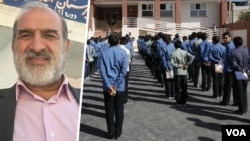An Iranian teacher’s union leader says Iran’s education system faces huge problems if the government goes ahead with a plan to restart a coronavirus-stalled school year in mid-April.
In a Monday interview with VOA Persian from Tehran, Ali Akbar Baghani warned that many Iranian students could be exposed to the coronavirus if required to return to crowded classrooms, while others could find themselves unable to connect to teachers if schools switch to online learning.
In remarks broadcast Sunday on state television, Iranian President Hassan Rouhani said a national closure of schools and universities would be extended to April 18.
Baghani, who serves as vice president of the Iranian Teachers’ Trade Association, was sharply critical of the planned re-opening date.
“It is practically unworkable to open schools with 30 to 50 students in each classroom, especially in Tehran,” he said. “If it happens, a disaster would be on the way, since there is no mechanism to enforce social distancing (in the schools)."
Iranian officials have been announcing a steady decline in daily new coronavirus cases in the past week, with just 2,000 new cases on Tuesday compared to 2,300 the day before. But some overseas health experts and human rights activists have accused Tehran of underreporting both cases and deaths and warned that a new wave of infection could emerge if the government eases social distancing rules and other restrictions on normal life too soon.
In his Sunday comments, Rouhani also called for the “use of cyberspace” in the process of re-opening schools, without elaborating. In a tweet the same day, Iran’s Information and Communications Technology Minister Mohammad-Javad Azari Jahromi touted what he said was a plan to upgrade internet speeds in the coming weeks to help create virtual classrooms.
Baghani said Iran faces “huge shortcomings” in getting schools to conduct classes online for elementary and high school students, who number 14 million according to state media.
“We are talking about a government that cannot provide enough chairs and desks for classrooms, let alone the infrastructure for virtual classrooms and online learning,” he said. “Online classes are good in theory, but would be a joke in Iran since not all students and teachers have access to sufficiently fast internet connections.”
Iranian authorities have arrested Baghani several times in the past decade in response to his advocacy for teachers’ rights. They also forced him to live in exile in eastern city of Zabol for several years.
Iranian Education Minister Mohsen Haji Mirzaei said in March 30 tweet that only 869,400 students have no internet access in Iran. But Iranian government data indicate that far more Iranian students lack the type of fixed broadband internet access that they would need to join virtual classrooms.
A September 2019 article by the semi-official ISNA news agency cited Iran’s Communications Regulatory Authority as saying only 12% of the population had fixed broadband internet as of March that year, while 78% of the country’s 80 million people did not.
By comparison, 94% of the U.S. population had fixed broadband internet access at the end of 2017, according to a February 2019 report by the Federal Communications Commission.
U.S. Commerce Department data show the rate of access to wired high-speed internet service in U.S. households with school-aged children in November 2017 was lower, at 86%.
This article originated in VOA’s Persian Service. Mehdi Jedinia of VOA’s Extremism Watch Desk contributed.










